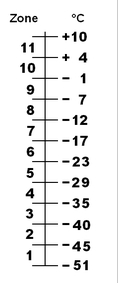Evergreen
Trees Zone 3 (with heights)
Larix
siberica- Larch (30m )
|
Picea
glauca –White Spruce (15m)
Picea
glauca ‘Densata’ –Black Hills Spruce (6m)
Picea
pungens- Colorado Spruce (15m)
Picea
pungens ‘Fat Albert’ (10m)
Picea
pungens ‘Glauca Globosa’ –Blue Globe Spruce (2m)
Pinus
contorta latifolia – Lodge Pole Pine (10m)
|
Pinus
aristata- Bristlecone Pine (13m)
Pinus
ponderosa- Ponderosa Pine (10 -12m)
Pinus
sylvestris- Scot’s Pine (13m)
Pinus
cembra- Swiss Stone Pine (4m-slow)
Thuja
occidentalis ‘Brandon’- Brandon Cedar ( 4m)
|
Evergreen
Shrubs Zone 3 (with heights and spread)
|
Arctostaphylos
uva-ursi- Bearberry (.15m, 60-120 cm wide)
Juniperus
chinensis ‘aurea’- Gold Coast Juniper (.75m tall, 1.5m wide- golden/green)
Juniperus
horizontalis ‘Blue Chip’-Blue Chip Juniper (.2m tall, 2.5m wide- silver blue)
Juniperus
horizontalis ‘Youngstown’-Youngstown
Andorra Juniper
(.3m tall, 1.75m wide-green)
Juniperus
horizontalis ‘Wiltonii’ –Blue Rug Juniper (.15m tall, 2m wide-silver blue)
Juniperus
horizontalis ‘Prince of Wales’- Prince of Wales Juniper
(.2m tall, 2.5m wide-bright
green)
Juniperus sabina ‘Calgary Carpet’-
Calgary Carpet Juniper (.3m tall, 1.5m
wide-soft
green)
Juniperus sabina
‘Monard’- Moor -dense Juniper (.3m tall, 1.5m wide- bright green)
Juniperus
sabina ‘Scandia’ – Skandia Juniper (.5m
tall, 2m wide-bright green)
Juniperus
scopulorum ‘Medora’- Medora Juniper (3m tall, 1m wide-blue green)
Juniperus
scopulorum ‘Moonglow’- Moonglow juniper (5m tall, 2m wide-blue)
Juniperus
scopulorum ‘Wichita Blue’-Wichita Blue Juniper (4m tall, 1.5m wide-silver blue)
Juniperus
squamata ‘Blue Star’- Blue Star Juniper (.6m tall, 1.25m wide-silver blue)
Juniperus
virginiana ‘Skyrocket’- Skyrocket Juniper (5m tall, 1m wide-blue green)
Microbiota
decussate- Russian Cypress (.15m tall, 2m wide)
Picea
abies ‘Little Gem’-Little Gem Spruce (.5m)
Picea
abies ‘Nidiformis’- Nest Spruce ( 1m)
Pinus
mugo ‘Mops’- Mops Mugo Pine (.6m)
Pinus
mugo ‘Pumilo’ – Dwarf Mugo Pine ( 1.25m)
Thuja
occidentalis ‘Little Giant’ – Little Giant Cedar (1m tall, 1m wide)
Thuja
occidentalis ‘Woodwardii’- Globe Cedar ( 1.75m tall, 1.75 m wide)
Photos:Colorado Spruce by:www.lawyernursery.com
Lodgepole Pine by:www.prairiescapes.ca
Calagery Carpet Juniper by:www.greentreelandscapes.com
|









